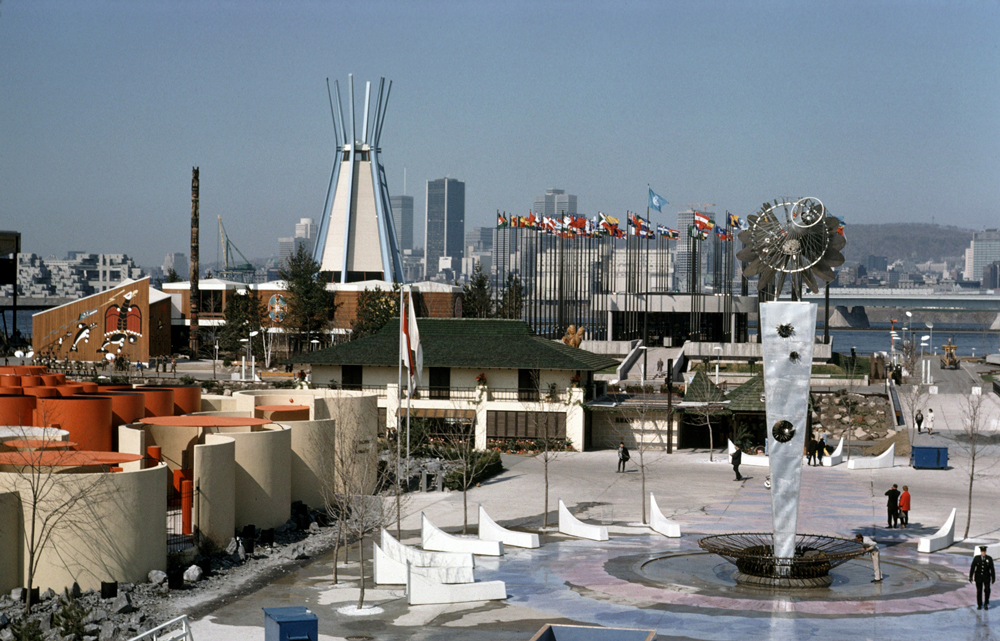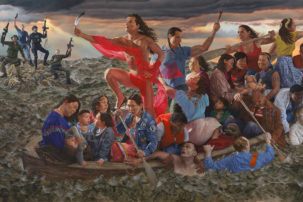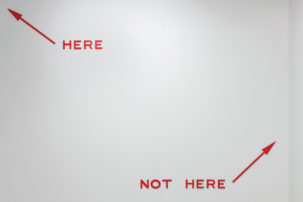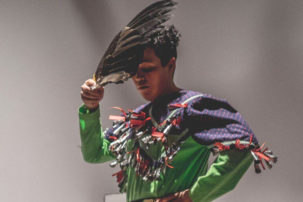Is art certain or uncertain? There is a long-held belief—or perhaps an aggressively held contemporary one, which feels eternal because it is now so common—that objects and images inherently provide routes to richer meanings, empowerments and ambiguities. Yet this is as untrue as it is true. A work of art has, in my mind, three simultaneous identities: as an object; as an image of the object presented to the viewer in reality, in replication (a textbook, a monograph, a website) or in memory; and as an idea that one can debate, interpret and discuss, one that can seem to float above and beyond the object entirely.
Art history students are taught that a photograph, basically an image object, openly lies—because it confidently, with scientific pretense, turns a moment into an object. It seems to assert a truth that can never fully be a truth. (“Do I really look like this?” is the common statement when seeing a photo of yourself. The actual answer to this can only ever be, “no,” or at best “sort of.”) Photographs can also tell us the very opposite of what they appear to want to tell us. (“A photograph is a secret about a secret,” photographer Diane Arbus famously said. “The more it tells you the less you know.”)
As social media and digital technology should teach us daily, performances we make for lenses can tell more about what we’re trying to hide than show. The performance of the image object, the photograph, can feel empty, because it is a cue to a richer and more complex reality that cannot be recorded. The image object can be tragic, ironically presenting, for example, happiness and fulfillment, as posed for the camera, which only remind us of unhappiness and lack of fulfillment—a there signifying a not-there, an indirectness that seems more direct than directness. Often, the more ordered and cheery the image object, the more traumatic its effect. As the Kinks put it in their 1968 song “People Take Pictures of Each Other,”
People take pictures of the Summer,
Just in case someone thought they had missed it,
Just to proved that it really existed.
People take pictures of each other,
And the moment to last them for ever,
Of the time when they mattered to someone.
Picture of me when I was just three,
Sat with my ma by the old oak tree.
Oh how I love things as they used to be,
Don’t show me no more, please.
A souvenir is a particular kind of image object. For this talk, which promises to “think through” potential cultural responses to Canada’s sesquicentennial year, the concept of the souvenir seems as good a place as any to start.
“The souvenir connects the collector with something larger, a place or an event, a public history whose meaning has already been determined,” writes Stephanie Marlin-Curiel, in the context of an essay examining South Africa’s Truth and Reconciliation Commission. “While the souvenir is public,” Marlin-Curiel writes, “it is privately collected.”
You are looking at a beer stein produced fifty years ago by Blue Mountain Pottery, ostensibly an iconic piece of Canadiana in the sense of this type of ceramic coming from a particular region of Ontario (Blue Mountain) and representing the logo, and the moment of, Canada’s centennial in 1967, fifty years ago. Unlike a souvenir of the concurrent companion event Expo 67, which, one presumes, you’d have to acquire on site, this souvenir is what you’d call commemorative.
As an object of nationalism, the stein is both a symbol, because it is a concrete thing that stands for something abstract (“Canada”; indeed, it bears Canada’s centennial logo), and it is also a metonym, because it is a part of a whole, standing for the whole but also made out of the same material as the whole—its very substance coming from the earth of the country it purports to celebrate.
******
Canada does not have a straightforward relationship with the souvenir. In the ’00s, Vancouver writer and artist Douglas Coupland published a two-volume coffee-table book titled Souvenir of Canada, the second volume coinciding with Coupland’s creation of the installation Canada House, in its first iteration a collection of Canadiana objects amassed in a disused relic of 1950s social housing in Vancouver. The objects later made their way into Coupland’s touring survey exhibition “everywhere is anywhere and anything is everything.”
There is a nervousness to Coupland’s project, one that comes from any attempt to curate an uncertain identity into certain being or inclusion. “We have to watch out,” Coupland writes in the first volume, “because our [i.e. Canada’s] reservoir of myths is far smaller and far more fragile than those of some other nations. Once the supplies dry up, they dry up.”
Coupland’s volumes are organized alphabetically. In his entry titled “Baffin Island,” he exhorts about all that Canadian land that, for his intents and purposes, appears unharnessed, unused. “What is a Canadian in a 747 en route from Vancouver to Frankfurt supposed to make of all that seemingly dead or dormant land? I often wonder if I’ll ever set foot on it, and pretty much doubt it. Will these vast refrigerated stones someday harbour modern cities and societies? Corner malls with a Lenscrafters and a Baskin-Robbins on Baffin Island? The Great Slave Lake Expressway?”
If it weren’t abundantly clear at the time of publication: this is the classic, settler-colonial, terra nullius observation, one that has plagued a white attempt to “make” “Canada” into “something.”
I don’t see Coupland as particularly shy about his subjectivity. But he is, as I already mentioned, nervous, even embarrassed. Essentially it is a nervousness or embarrassment about Canada somehow not being suitable to, say, the Pop Art treatment—about Canada’s so-called uncool, unremarkable participation in late capitalism, one depriving it of a sheen other countries have deployed culturally, specifically in a clever, ironic or kitschy way (more on kitsch in a moment).
Evident in Coupland is a melancholic (sulky?) detachment from the process of souvenir-making—an implication that the Canadian souvenir is neither metonym nor metaphor, for it has a presumed hollowness to it, either because it represents a strained, obscure element of culture that cannot fully be shared and understood across regions, or it represents, even comes from, a place to which you (“you”) are likely never to go. For Coupland, “Canada” is a failed brand.
Souvenir of Canada is akin to the Group of Seven, an art project about nationalism that, in its uncertainties, can feel more settler-colonial, in its way, than something certain. Enmeshed in the banalities of an unsexy colony, such aesthetic-cultural perspectives look out from entitled white neutrality to see one of three things: “nothing”; the prosaic; the beautiful and sublime, regarded from afar, from the window of a 747, or the frame of a painting. And so for Coupland, the Canadian souvenir feels, to use a problematic but apt expression here, lame. At best it is an inside joke about its own lameness.
******
In the exhibition “Shame and Prejudice: A Story of Resilience,” artist Kent Monkman marks Canada’s sesquicentennial by presenting another type of souvenir. In an early section of Monkman’s exhibition decrying the genocide on which this country is founded, he presents drawings and text from the journals of Jesuit priest and missionary Nicholas Point, who in the 1840s spent time with the Indigenous peoples of the Northwest Coast, with these journals eventually collected in the volume entitled Wilderness Kingdom: Indian Life in the Rocky Mountains, 1840–47. The particular souvenir I refer to is number 28 in the journal, and it is called “Souvenirs d’une premiere communion.” The following inscription appears below a watercolour depicting a group of Indigenous peoples perched on a cloud underneath a glowing chalice, reading, and I translate from French: “The attitude of some Indians one evening on which they were heard repeating the principal stanza of that happy day, Lauda Sion Salvatorem.”
Monkman’s presentation of Point’s work is destabilizing on a number of levels. In a well-known October magazine article from 1984 entitled “Of Mimicry and Man: The Ambivalence of Colonial Discourse,” Homi Bhabha writes that “mimicry emerges as one of the most elusive and effective strategies of colonial power and knowledge.” But it is also “a difference or recalcitrance which coheres the dominant strategic function of colonial power, intensifies surveillance, and poses an immanent threat to both ‘normalized’ knowledges and disciplinary powers.” In other words, mimicry is not meant to be successful, even when it is successful. For Point to depict the assimilation of Northwest Coast Indigenous peoples means, for the dominant power, an expression of an “out-of-place” act that confirms, here in a visual and ostensibly and actually disturbingly naïve manner, the inability of Indigenous peoples to ever fully assimilate, to “pass.” Is this a tragedy or a triumph?
Monkman of course is interested in the other mimicry Bhabha speaks of, a mimicry of resistance that “is at once resemblance and menace.” In Catholicism, a souvenir relates heavily to the denomination’s storied traditions of slippery semiotics, where, in transubstantiation, object becomes spirit; in relic, object delivers spirit; in souvenir, spirit is commemorated through object. For Monkman, kitsch is vital. For if the definition of kitsch is to appreciate an obviously tacky or sentimental object ironically, for its brilliant execution of tackiness or sentimentality, then kitsch excludes through its scrupulous gaze. It is supercilious, condescending, a perfect tool of settler-colonialism. It is no wonder that women and people of colour often become belittled, servile objects in kitsch: think of the sinuous, naked female bodies of art nouveau sculpture, or the antebellum nostalgia of ceramic “mammies.” But what if the kitsch object were subject? Monkman and many other artists deploy such reappropriation with an equal but opposite sentimentality. It is a sentimentality that holds Bhabba’s “menace,” one so sweet it curdles. One could criticize it for being reactive rather than solely generative—but these objects, this history, they are so heavy.
I think at this point it is clear that I believe not just the sesquicentennial, but any and all nationalist anniversaries, are bullshit, relevant only to mark the hauntings and pressing realities of colonialist legacies. A souvenir is a touristic item. And souvenirs can come in many forms, not just as objects one can hold in one’s hand. A monument is a souvenir; in the case of Canada’s centennial in 1967, buildings, sprung from centennial make-work projects, were also souvenirs. A nationalist anniversary, and indeed any nationalism, is thus tied to the products that are produced from this mood or sensibility. Such anniversaries are meant to draw tourists from elsewhere, in order to regard the country-in-celebration as clear, proud and purposeful. Readers of the late German philosopher Walter Benjamin might think of his concept of the phantasmagoria as applied to the idea of the World’s Fair: essentially that these events can make the most banal objects appear consumable, charged with modes of propaganda, commitment, fidelity, loyalty, magic, transformation.
Nationalist projects, dependent as they are on paradigms of “utopia” (a word that literally means “no place”) necessarily open up to practical dystopias. The promise can never—and of course shouldn’t—be fulfilled in execution. This can be a nightmarish state, in which overdrawn nationalism peals over dissent, present and historical violence, etc. This state can also produce sites of negotiation, struggle, resistance and potential healing, which often involve attempting some kind of embodiment of the souvenir. For lack of a better phrase, this is a relational act: where actual bodies, actual felt experience, actual, sensitive acknowledgments of the land, mark an encounter with the presented souvenir, questioning it and ultimately harnessing the nationalist anniversary as a moment of implicating, contemplative unraveling.
******
I’d like to briefly visit Expo 67, an event that coincided with Canada’s centennial and which pivoted on the concept of the souvenir. This is the clever contention of scholars Rhona Richman Kenneally and Johanne Sloan’s 2010 anthology, entitled Expo 67: Not Just a Souvenir. This book has been a vital source of inspiration for this talk. Throughout, Richman Kenneally and Sloan acknowledge Expo as an exciting phenomenon for the country that has become known as Canada—one that connected it to a kind of internationalism it had thus far only dreamt of. But Richman Kennealy and Sloan’s anthology does not rest on a pure celebration of the souvenir. Rather, it upholds a heavily souvenirized event as a dystopic opportunity that many took to heart, to question the very idea of the souvenir, the objectification of the Canadian (“Canadian”) experience, under the shadow of celebration.
The very grounds of Expo 67 suggest a colonial project related to Bhabba’s concept of mimicry, and to the idea of the souvenir as metonymic object. The event took place on Île Sainte-Hélène, which was named by Champlain, used as a military stronghold after the War of 1812, and housed a prison for POWs during World War Two. For Expo, 25 million tons of fill were taken from excavations from the construction of the Montreal Metro. In this material sense, Expo stood for: the contemporary development of the urban infrastructure of Canada’s largest city at the time; the colonial history of the country known as Canada; and microcosmically, a miniature version of the world, removed from the world yet in it. Richman Kenneally and Johanne Sloan relate the immediate souvenirification of the Expo experience: a passport that each visitor received upon entry. In the context of today’s political climate of isolationism and white nationalism, this passport seems disturbingly naïve. The thematic of Expo was Terres des hommes / Man and His World, a phrase borrowed from French writer Antoine de Sainte-Exupéry—something else that seems quaintly offensive to our eyes. However, as Sloan and Richman Kenneally write, “if Expo 67 shows the popularity of this brand of humanism at this particular time, its intellectual foundation was nevertheless under threat as well.” Returning to how this talk began, Expo was indeed full of images that conveyed certainty, ones that in their very confidence opened up uncertainties. “[It] was a highly photogenic event,” Sloan and Richman Kenneally write, “and the experience of it was largely constituted in visual and pictorial terms.” In another essay, Kenneally calls the event “a celebration of sight.”
There is not enough time to fully parse the event, about which books have been written and classes taught, but its salient features for the purposes of this talk involve its expression of the concept of Canada, and its use and charged inclusion of Indigenous peoples.
You are looking at a gatefold representation of the Canada Pavilion as depicted in an aerial photograph in a souvenir coffee-table book of Expo. The most impressive aspect of the structure was the katimavik, an inverted pyramid structure named after a phrase in Inuktitut meaning “meeting place.”
Within the Pavilion was a restaurant, La Toundra or Tundra, still in varied existence, which further appropriated Inuit cultures. The carpet alone is an example of dystopic mimicry, done in gold, green and orange synthetic fibres meant to represent “tundra colours.” Inuit life was depicted in a large mural, carved into the plaster of the restaurant’s walls, by two artists from Cape Dorset, Elijah Pudlat and Kumukuluk Saggiak. Despite the rest of Tundra having more obvious signs of colonial possession, reinterpretation and plundering—seats upholstered in sealskin, servers wearing parka-like “soft tan jackets with black turtleneck sweaters”—the mural, made by Inuit artists, depicted the modernization of the Far North we are now used to seeing in drawings that continue to come out of, among other places, Cape Dorset. A variety of igloos coupled with colonial houses and industrial ships coupled with sleds: if one examined the plaster carvings with more than a passing glance, it became clear that dissent or at least realism became legible through the neo-colonialist kitsch.
*****

What was to become known as the “Indian Pavilion” was not part of the Canada Pavilion of Expo 67, although initial plans included Indigenous presence there. In the words of a planning document from the Department of Indian and Northern Affairs, the concept was to have “some Indian artifacts be dimly spotlighted amidst a dreamworld forest.” Resistance to this plan—one understandable given the exclusionary language of this quotation—came from the advisory committee set up by the Department. The history and impact of the Pavilion are not straightforward or agreed-upon; at the very least, the Pavilion can be seen as somewhat illustrative of the kinds of threats to blind nationalist celebration that Sloan and Richman Kenneally assert. Commonly circulated criticisms include the central use for the pavilion of the Plains structure of the Tipi, an object of “performing Indian” familiar to viewers of film and television Westerns; as well as the siphoning of Inuit voices to Tundra and the Canada Pavilion. (In this context, architect F.W. Francis’s statement that the structure would “produce a coherent and unifying whole, and, we hope, a strong Indian identity” seems misguided, offensive.)
But there are Indigenous scholars who see the Pavilion as unusual and challenging. Ruth B. Phillips and Sherry Brydon assert that, at the pavilion, which actively involved and employed Indigenous artists, thinkers and designers, “the installations affirmed the contemporary value of cultural difference and the survival of traditional values and beliefs in the face of great odds. The evidence of this survival—and of successful adaptations to the modern world—was expressed most vibrantly and concretely by the remarkable assemblage of contemporary Indigenous art commissioned for the pavilion’s exterior and also displayed inside.” The Tipi structure itself, designed by architect J.W. Francis, poked up from behind the UN pavilion, with its panorama of flags. It is a kind of irony that, in photos at least, seems to confirm that within this “celebration of sight,” there were many opportunities to ironize, perhaps because this celebration was so aggressively optimistic on its surface. But the placement of the pavilion also, according to Phillips and Brydon, “[proved] opportune, for it gave the Aboriginal people who worked at the Indians of Canada Pavilion valuable opportunities to make contacts with the many international officials who came to visit the neighbouring building.”
Other works decorating the pavilion also played with the idea of the souvenir—particularly charged within the context of Indigenous art, as the “souvenir” remains the a dominant context in which settler-colonial culture understand the way in which Indigenous art is made and consumed. Phillips and Brydon make the somewhat convincing argument that these decorative works—by Alex Janvier, Tom Hill, Gerald Tailfeathers, Norval Morrisseau and others—“stand at the beginning of a shift” as they marry more typical “performing Indian” images of spirituality and animism with an awareness of modernist art, a sign, according to these scholars, of the perseverance and adaptability of Indigenous art despite marginalization. Yet viewers would not, given the “noble savage” semiotics of the Tipi outside and its surrounding colourful murals, have anticipated the relatively nuanced and challenging ideas contained within. In this sense, the structure and design of this pavilion and its souvenir function can be seen as a kind of Trojan horse.
The central question of the exhibition within the Indian Pavilion was, as addressed to Indigenous peoples, “What do you want to tell the people of Canada and the world when they come to Expo?” The resulting answers, displayed on graphic didactics throughout, were compiled by the non-Indigenous Robert Marjoribanks in collaboration with members of the Indigenous advisory committee for the pavilion. The exhibition was divided into pre-contact histories, colonial histories, meditations on the present, and the future.
There is not time to completely delineate the exhibition, and in fact no official record of it exists, but some examples: a display on the impact of missionaries, featuring a sculpture of a celestial bear carved by Nathan Montour with a projection of a cross onto it, and background text reading, in English and French, “The early missionaries thought us pagans. They imposed upon us their own stories of God, of Heaven and Hell, of Sin and Salvation”; a display on education, with the following text, “Dick and Jane in the storybook are strangers to an Indian boy. An Indian child begins school by learning a foreign tongue. The sun and the moon mark passing time in the Indian home. At school, minutes are important and we jump to the bell. Many precious hours are spent in a bus going to a distant school and coming home again.”
The Department of Indian and Northern Affairs demanded supplementary displays with stats showing increases in student enrolment over the decades, but of course we now recognize the dark implications of such statistics—and, perhaps, of how powerfully this particular display resonated with many visitors and, subsequently, with scholars.
******
The cracking of the souvenir evident at Expo 67 and Canada’s centennial more generally should give us a strong indication of how our current sesquicentennial must be handled—as a deliberate move away nationalist and settler-colonial celebrations that depend on reductive, materialized, concretized, spatialized, curated images and objects, ones often bought and sold. Fascinating to me in my research for this talk was the advent of the “Centennial Voyageur Canoe Pageant” in May of 1967, for which teams representing the provinces and territories raced against each other, following the path of early colonial explorers across the country by beginning at Rocky Mountain House and landing in Montreal on September 4.
According to Wikipedia, as of March 2012, this event still holds the Guinness record for longest canoeing race in history. A lesser-known fact, asserted by scholar Eva-Marie Kröller, are the Indigenous activities that were organized in direct response to this: fourteen Mi’kmaq who, in the words of Pierre Berton, staged a “thousand-mile, forty-five-day canoe trip from Cape Breton to Montreal to relive an 1894 treaty signing between their people and the Quebec Iroquois.” According to Kröller, Indigenous peoples were also involved in the official race, although the media coverage of their participation tended to be dismissive. Another irony: the organizer of the centennial race was Gene Rhéaume, first Métis MP since Louis Riel.
The most fascinating and successful pieces of sesquicentennial celebrations thus far appear to fall along the lines either of the embedded subterfuge of the Indian Pavilion, or the relational refusal of the Mi’kmaq response to the centennial pageant. In January, Canadian Art ran a story researched by Leah Sandals on the resistance taking place against Canada 150 essentially from the stroke of midnight on January 1, 2017. Artist Chippewar (a.k.a. Jay Soule of Thames First Nation) posted a satirical version of the Canada 150 logo on his Instagram feed early in the New Year. These logos are also available as free sticker packs on his website, and read “Canada 150 Years of Genocide,” “Canada 150 Years of Assimilation” and “Canada 150 Years of Broken Treaties”; online they are posted with similar hashtags. Eric Ritskes, founder and editor of the open access journal Decolonization: Indigeneity, Education and Society, posted an upturned version of the Canada 150 logo on social media and the response was so overwhelming that he put it on T-shirts as a fundraiser for Onaman Collective, an Indigenous grassroots land-based art initiative sharing traditional knowledge and language with youth.
Some art projects forgo the souvenir entirely. Here, the land, and Indigenous bodies within the land, resist not just the souvenir but its related context, the gallery—with its Benjaminian phantasmagoria, indeed with its promise of epiphany embedded within a retail-like environment divorced from the land and the body. Rebecca Belmore’s Speaking to Their Mother (Ayum-ee-aawach Oomama-mowan) was originally presented in the early 1990s in the wake of the Oka Crisis—an iconic work of contemporary art that involved the placement of a large megaphone in a meadow of Banff National Park, Canada’s first park designated as such. Various participants spoke through the megaphone in an address to the land, which echoed back their voices.
Now, for LandMarks, Belmore presents an inverse of this project, Wave Sound: “a device,” says curator Kathleen Ritter, “through which people can listen to the land rather than speak to it.” In this project, situated in four parks across the country, fitted sculptures allow people to contemplate to the sound of the land. “It does feel kind of obnoxious to make objects that will then be placed out in nature,” says Belmore in a recent interview with Canadian Art’s Indigenous Editor-at-Large Lindsay Nixon. “I did struggle with it, to be honest. This is how I solved my problem: to insert an object, an artwork, into the landscape is pretty challenging and humbling, and I had to figure out how to do that in a respectful way.”
In Canadian Art’s Winter issue, themed “Futures,” writer and scholar Julie Nagam writes both of how Indigenous artists are using digital technologies to assert new, or renewed, agencies and existences within cyber space, but also of the Indigenous commitment to moving beyond the artificial settler-colonial constructs of, say, a nationalist anniversary, a national park, a souvenir. Describing a 2011 performance work of Alberta Métis artist Amy Malbeuf entitled Unbodied Rebirth, Nagam writes, “Malbeuf stands in a snow-covered forest and unpeels layer after layer of artificially coloured ‘skins’ to become naked in the environment. Lying on the snow, she is intrinsically bound to the land, her body representing the eternal relationship to that place that her foremothers have had over eras.”
Can the culture made around the sesquicentennial create not objects, but reactivate, assert and empower marginalized bodies, not only bringing forgotten histories to light, but reorienting the consumption model of art as an image-object or souvenir to be gawked at, owned, mounted and/or eventually discarded? For white, settler-colonial Canada, the sesquicentennial is an occasion not for beer-guzzling, for passive, entertainment-oriented culture, indeed for performative guilt, but rather for listening—quiet and intent listening. Writes Nagam:
“The land speaks. It will tell you stories if you want to listen. Our land has spanned countless millennia. It is the only living thing that can tell us what the future might hold, for the reason that it stores knowledge in the rocks, trees, water and deep within the earth. For Indigenous artists, our future is interconnected with the land and what it has to tell us. Our ancient stories are futurist, whether they have foretold of the birth of twins, how the world was made on the back of a turtle, the transformation of animals, mythic creatures that live deep in the water or what the cosmos tell us—these stories are predicting our future. Artists have the ability to translate these stories into visual narratives. Indigenous artists mobilize ancient knowledge to mark, map out and foresee the future.”
David Balzer is editor-in-chief at Canadian Art. This post is adapted from a transcript of his talk “What Now: Thinking Through Canada 150” that took place at the Gardiner Museum in Toronto on February 27, 2017.

 Canada 150 souvenirs on sale in Toronto. Photo: David Balzer.
Canada 150 souvenirs on sale in Toronto. Photo: David Balzer.







